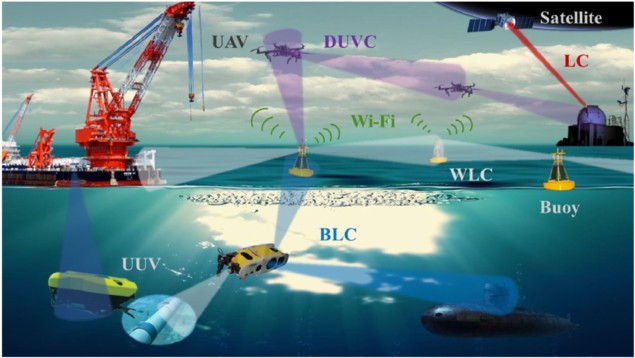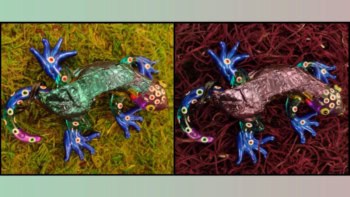
Researchers in China have demonstrated a prototype communications network that can transmit and receive data through space, air and water entirely at optical wavelengths. If successfully scaled up, the new network design might have applications as diverse as navigation, ecological monitoring, remote sensing, emergency aid and connecting devices within the so-called “Internet of Things”.
Many of today’s optical communications networks are designed to work in just one medium: underwater, over land, through space or in the air. Creating a single system that can operate in all of these environments is no easy task, as the requirements of each are different. Fulfilling them requirements thus means combining multiple technologies.
A team led by microelectronics expert Yongjin Wang of the Nanjing University of Posts and Telecommunications and Suzhou Lighting Chip Monolithic Optoelectronics Technology Co. Ltd. has now done just that by employing four different light sources to establish simultaneous wireless light communications links in any of these environments. “Our new wireless network enables uninterrupted connectivity across environments, facilitating two-way real-time data transmission between the network nodes that carry out communication and data exchange within and between networks,” Wang says.
Four full-duplex wireless light communication links
For the underwater portion of their network, the researchers chose blue light because seawater absorbs less in this part of the electromagnetic spectrum, meaning light can travel further. To communicate with airborne device such as drones, they used deep ultraviolet light because it provides “solar-blind” communication with no interference from sunlight. For other air-based applications, they used wireless white light communication, while for point-to-point communications in free space they selected near-infrared laser diodes. These diodes emit light in one direction with high optical power, again allowing the signals to travel further.

“Our network consists of these four full-duplex wireless light communication links, which are connected in series via Ethernet switches,” explains Wang. “Both wired and wireless access to the all-light communication network is also possible, providing flexible connectivity options.”
Separating the different light bands also prevents signals from interfering, meaning the network can transmit many signals simultaneously without compromising performance, Wang says. The network can be connected to the Internet via a modem, granting people in remote ocean locations, for example, access to the backbone network for information sharing. It also allows video conferencing and other transmissions via the widely-used TCP/IP (Transition Control Protocol/Internet Protocol) suite, he adds, making it suitable for Internet of Things applications, too. “For example, when a 2560 × 1440-pixel online video at 22 frames per second are fed into the network, users accessing the network from any node can visit this video with little lag,” he tells Physics World.

What would happen if communication systems broke down?
From a single communication system to a network
According to Wang and colleagues, the all-light communication network is a “major breakthrough”, one that should make it possible to transition from single wireless light communication systems to a network of them. Such a network would resist electromagnetic interference (EMI), making it particularly attractive for communicating with underwater equipment and drone clusters. “This is why are we working on integrating mobile nodes in the network, rather than fixed nodes, as is presently the case,” explains Wang. “This will not be easy, however, since it will require tacking the challenge of ‘light alignment’ and network establishment speed.”
The researchers, who describe the new network in Optics Express, also plan to enhance the throughput of their communication network by using a technique called wavelength division multiplexing. This, they say, will improve the network’s overall efficiency and performance by eliminating the delays associated with using near-infrared laser diodes.



